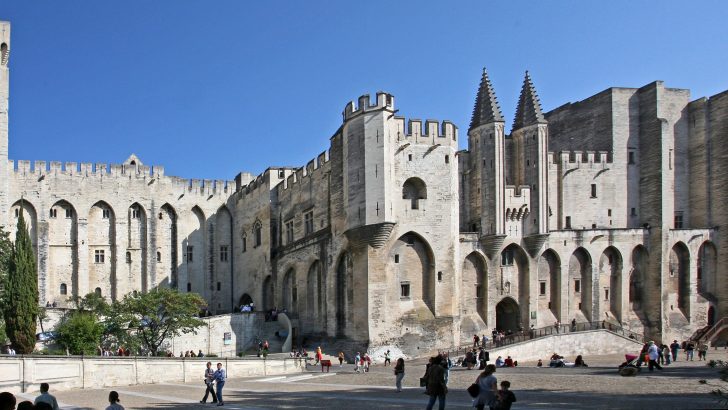The World of Books
There are many people who see the Church of the Middle Ages as being an institution not only at the peak of its sanctity, but also as a model from which modern society can learn. I suspect that this view, especially in Ireland, owes much to the views of Chesterton and Belloc, gained at second-hand from American sources.
However, a visit to Avignon in Provence would quickly set these ideas into the context of medieval reality. For it was here, in an enclave of the Papal States that the Popes ruled, that the papacy was established for over a century during what is sometimes call the Great Western Schism.
What the visitor sees today is the great Palais des Papes. I first saw this in the early 1960s as a boy, on a baking hot August afternoon. All I can recall was the blazing white of the square and the sheer walls of the palace. But a more recent visit enables my older self to see it again in the gentler, but still (by Irish standards) very warm spring of Provenance.
But how it was that the Popes came to be there in the first place that provides the real lesson of history.
In 1305 the then Bishop of Bordeaux, Bertrand de Got, was elected Pope under the name of Clement V. Due to the difficulties reigning in Rome at the time, where dissension backed by military force was much in vogue, Clement was induced by King Philippe of France to move to Avignon, which though outside Italy had nevertheless been a possession of the papacy, as the Comtat Venaissan, since 1274. Clement did not stay much in Avignon, preferring a monastery in Malaucene.
Successor
When he died in 1314, it took two years to select his successor. So from 1309 to 1377, seven French Popes succeeded each other. Then the cardinals, who were mostly French and had mansions of their own across the Rhone in Villeneuve d’Avignon, disliked the reforms of Urban VI, and elected a rival Pope, Clement VII (1378-94).
With a Pope in Rome and now an anti-Pope in Avignon, Christendom was sundered. The residence of the Popes in Avignon had been called “a Babylonian captivity”. But the prelates in Rome called what occurred “the Great Schism”, forgetting the far more serious breach with the Eastern Church. The rival popes denounced and excommunicated each other. At last Benedict XIII fled Avignon having lost the support of the French king.
In 1417 the Schism came to an end with election of Martin V. Avignon was now ruled (down to the time of the French Revolution) by a papal legate. Under papal rule Avignon was a very tolerant city.
There was a free press beyond the reach of the royal censors in Paris. There was a thriving Jewish community – political exiles found refuge there as well. But so too did the sort of shady financiers and criminals that swarm everywhere there is wealth.
When finally the revolution came the constitutional assembly voted to break with Rome and attach the Comtat to the French state, under the various monarchical, imperial and republican guises that followed over the centuries since. (The rest of the Papal States were seized by the new united kingdom of Italy after the Risorgimento in 1870.)
The events at Avignon can be seen, in a sense, as a prelude to the more lasting divisions of the Reformation that followed a century later. Contemplating this story many will perhaps think that affairs in Rome today, though not always what many of the laity would want, are in far better state than they were at the time of the Western Schism.
For every admirer of the Middle Ages, the city of Avignon, over which was laid the benign hand of the great restorer Viollet-le-Duc in the 19th century, is well worth a visit. But try the cooler less crowded months rather than August. It may not be a papal paradise today, but visitors do not have to suffer a Roman inferno to enjoy its heritage of art and architecture.


 Avignon
Avignon 